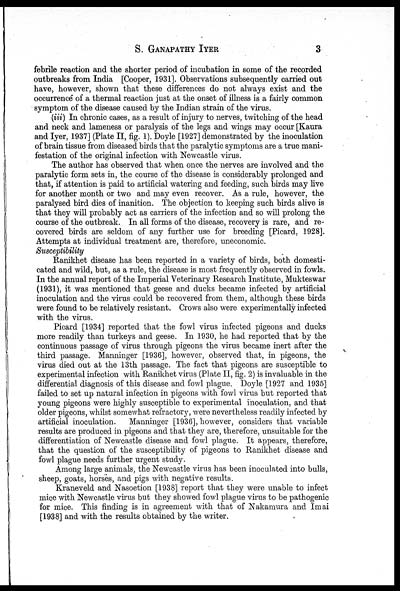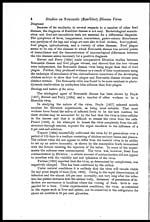Medicine - Veterinary > Veterinary colleges and laboratories > Indian journal of veterinary science and animal husbandry > Volume 13, 1943 > Original articles > Studies on Newcastle (Ranikhet) disease virus
(21) Page 3
Download files
Individual page:
Thumbnail gallery: Grid view | List view

S. GANAPATHY IYER 3
febrile reaction and the shorter period of incubation in some of the recorded
outbreaks from India [Cooper, 1931]. Observations subsequently carried out
have, however, shown that these differences do not always exist and the
occurrence of a thermal reaction just at the onset of illness is a fairly common
symptom of the disease caused by the Indian strain of the virus.
(iii) In chronic cases, as a result of injury to nerves, twitching of the head
and neck and lameness or paralysis of the legs and wings may occur [Kaura
and Iyer, 1937] (Plate II, fig. 1). Doyle [1927] demonstrated by the inoculation
of brain tissue from diseased birds that the paralytic symptoms are a true mani-
festation of the original infection with Newcastle virus.
The author has observed that when once the nerves are involved and the
paralytic form sets in, the course of the disease is considerably prolonged and
that, if attention is paid to artificial watering and feeding, such birds may live
for another month or two and may even recover. As a rule, however, the
paralysed bird dies of inanition. The objection to keeping such birds alive is
that they will probably act as carriers of the infection and so will prolong the
course of the outbreak. In all forms of the disease, recovery is rare, and re-
covered birds are seldom of any further use for breeding [Picard, 1928].
Attempts at individual treatment are, therefore, uneconomic.
Susceptibility
Ranikhet disease has been reported in a variety of birds, both domesti-
cated and wild, but, as a rule, the disease is most frequently observed in fowls.
In the annual report of the Imperial Veterinary Research Institute, Mukteswar
(1931), it was mentioned that geese and ducks became infected by artificial
inoculation and the virus could be recovered from them, although these birds
were found to be relatively resistant. Crows also were experimentally infected
with the virus.
Picard [1934] reported that the fowl virus infected pigeons and ducks
more readily than turkeys and geese. In 1930, he had reported that by the
continuous passage of virus through pigeons the virus became inert after the
third passage. Manninger [1936], however, observed that, in pigeons, the
virus died out at the 13th passage. The fact that pigeons are susceptible to
experimental infection with Ranikhet virus (Plate II, fig. 2) is invaluable in the
differential diagnosis of this disease and fowl plague. Doyle [1927 and 1935]
failed to set up natural infection in pigeons with fowl virus but reported that
young pigeons were highly susceptible to experimental inoculation, and that
older pigeons, whilst somewhat refractory, were nevertheless readily infected by
artificial inoculation. Manninger [1936], however, considers that variable
results are produced in pigeons and that they are, therefore, unsuitable for the
differentiation of Newcastle disease and fowl plague. It appears, therefore,
that the question of the susceptibility of pigeons to Ranikhet disease and
fowl plague needs further urgent study.
Among large animals, the Newcastle virus has been inoculated into bulls,
sheep, goats, horses, and pigs with negative results.
Kraneveld and Nasoetion [1938] report that they were unable to infect
mice with Newcastle virus but they showed fowl plague virus to be pathogenic
for mice. This finding is in agreement with that of Nakamura and Imai
[1938] and with the results obtained by the writer.
Set display mode to: Large image | Zoom image | Transcription
Images and transcriptions on this page, including medium image downloads, may be used under the Creative Commons Attribution 4.0 International Licence unless otherwise stated. ![]()
| Permanent URL | https://digital.nls.uk/75472362 |
|---|
| Description | Covers articles from 1943. |
|---|




